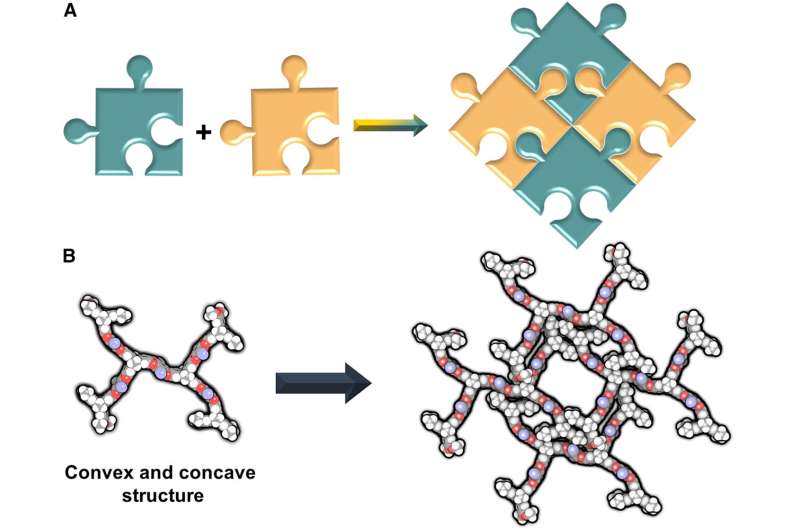This article has been reviewed according to Science X's editorial process and policies. Editors have highlighted the following attributes while ensuring the content's credibility:
fact-checked
peer-reviewed publication
trusted source
proofread
Crafting molecular puzzles: A strategic approach to developing robust porous molecular crystals

Inspired by jigsaw puzzles, Prof. Zhao Yanchuan and his research team from the Shanghai Institute of Organic Chemistry (SIOC) of the Chinese Academy of Sciences have developed a stable, porous molecular crystal (PMC) through a method they call "interdigitation-directed self-assembly."
As described in their article in the journal Cell Reports Physical Science, the researchers used a propeller-shaped molecule, triptycene, known for its ability to generate porosity and its unique concave-convex structure, as a building block to construct the molecular assembly.
PMC—an intriguing, crystalline, porous material—is formed from discrete organic molecules through noncovalent interactions. Its unique properties, such as high solubility, self-healing capabilities, and structural flexibility, have attracted increasing interest.
However, compared to well-established networked porous materials such as metal-organic frameworks and covalent organic frameworks, the relatively weak and less directional noncovalent interactions make PMC less stable, posing a major obstacle to the fabrication of robust porous materials.
In this study, the team's findings, validated by single-crystal X-ray diffraction, indicate that this self-assembly is driven by interdigitation and maintained by weak van der Waals interactions, thus acting like molecular jigsaw puzzle pieces.
The resulting PMC has a Brunauer–Emmett–Teller specific surface area of 752 m2/g. The stepwise adsorption and substantial hysteresis of the nitrogen sorption isotherms confirm the flexibility of this synthesized PMC, a fact further corroborated by structural simulations performed in collaboration with Prof. Zhou Wei from the National Institute of Standards and Technology of the U.S..
In addition, this synthesized PMC exhibits excellent thermal and chemical resistance, maintaining its crystallinity and specific surface area even after being immersed in highly concentrated NaOH, HCl, or boiling water.
In preliminary application tests, this PMC showed excellent rhodamine B adsorption capacity in water (707 mg/g) and high CO2/N2 selectivity.
This novel strategy of interdigitation-directed assembly offers significant potential for adaptation with a variety of building blocks. It could pave the way for the construction of porous architectures using weak van der Waals interactions, thus stimulating further innovation and progress in the field.
More information: Nie Fang et al, Layered porous molecular crystals via interdigitation-directed assembly, Cell Reports Physical Science (2023). DOI: 10.1016/j.xcrp.2023.101508
Journal information: Cell Reports Physical Science
Provided by Chinese Academy of Sciences





















